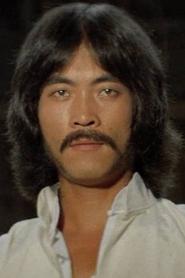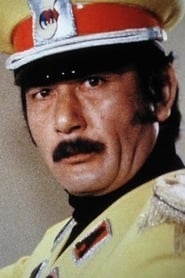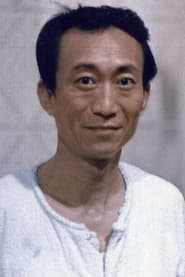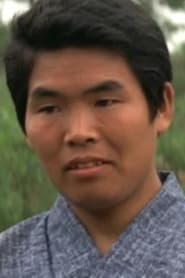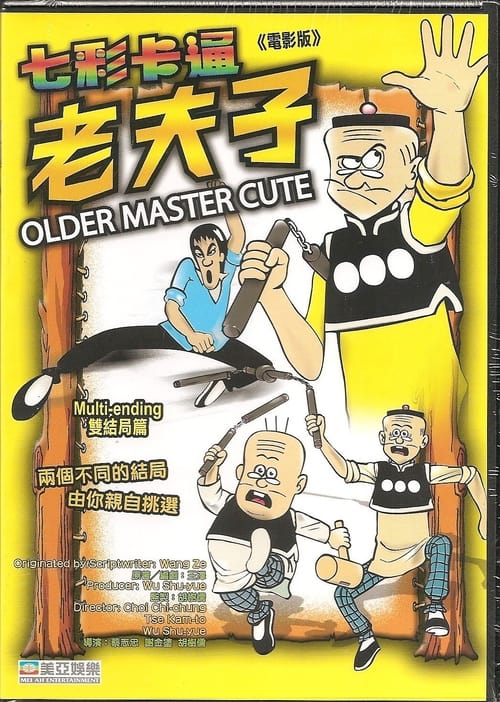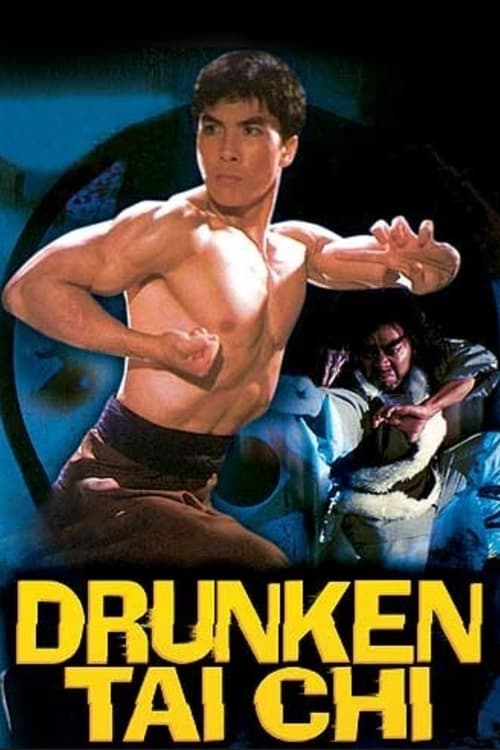
Ask Your Own Question
What is the plot?
The story of Ninja in the Dragon's Den opens in early 1980s Japan, shrouded in shadows and vengeance. Genbu, a young and deadly ninja clad in black, moves silently through the night, his mission clear and merciless: to avenge his father's death by assassinating those responsible. One by one, high-ranking officials linked to his father's downfall fall to his precise blades. His face is calm, his resolve unshakable, as he dispatches his targets with cold efficiency. His wife, Akane, accompanies him, a silent witness and partner in this dark quest. But Genbu's final target, a man named Fukusa--now living incognito in China--remains elusive, and the ninja clan's leader Sanchiro, the kashira, relentlessly pursues Genbu and Akane, determined to bring them back or eliminate them for their betrayal.
Crossing the sea into China, the tone shifts abruptly. The camera zooms into a bustling local festival, alive with color and noise, where we meet Sun Jing, a cocky and talented young kung fu master. He is a stark contrast to the grim ninja. Sun Jing's charisma radiates as he taunts and humiliates others with his martial arts prowess, his grin wide and confident. His sidekick Chee, a lecherous and comic relief figure, follows him around, often engrossed in smutty books and delivering humorous banter. Their camaraderie lightens the mood, but beneath the surface, tension simmers as Sun Jing's antics stir trouble. At the festival, Sun Jing faces off against a performer playing the Bull God in a spectacular fight on stilts. The battle is chaotic and thrilling, with both men balancing precariously high above the ground, their movements a blend of skill and daring acrobatics. The Bull God performer attacks with ferocity, and Sun Jing's quick reflexes and cunning allow him to triumph, earning cheers from the crowd.
Sun Jing lives with his uncle Fukusa, a quiet, aged man who keeps to himself. The audience soon learns that Fukusa is no ordinary elder; he is the retired ninja Genbu seeks. Fukusa's past is shrouded in mystery--once a skilled ninja himself, he fled Japan years ago to escape the deadly politics of the ninja clans. His presence in China has drawn unwanted attention, and Genbu's arrival spells danger not only for Fukusa but for Sun Jing as well.
The story's tension escalates when Genbu arrives in Sun Jing's village. Their first encounter is electric with hostility. Genbu's mission is clear: kill Fukusa to avenge his father. Sun Jing, protective of his uncle and confident in his own martial skills, confronts Genbu. Their initial fights are brutal and spectacular, blending ninja stealth and illusions with Sun Jing's raw kung fu power. In one intense sequence, they battle inside an ancient temple filled with deadly traps--spikes, swinging blades, and hidden pitfalls designed to ensnare unwary ninjas. The temple's labyrinthine corridors echo with the clash of weapons and grunts of exertion. Genbu's ninja illusions confuse Sun Jing, but the young martial artist's keen instincts keep him alive. Their combat is a dance of death, each testing the other's limits.
Meanwhile, Sanchiro, the ninja clan leader, arrives in China with a contingent of ninjas to capture or kill Genbu and Akane. The relentless pursuit leads to several skirmishes, with ninjas burning alive in fiery traps, limbs severed, and bodies falling in brutal combat. The film does not shy away from graphic violence--ears are sliced off, men dive into lakes of burning oil, and the air is thick with smoke and blood. Akane fights alongside Genbu but is ultimately overwhelmed during one confrontation, her fate left ambiguous as she disappears amidst the chaos.
Amid the escalating violence, a darker force emerges: The Magician, a master of demon-spiritualistic kung fu, who manipulates events from his lair. His cult wields supernatural powers, summoning demons and using mystical artifacts to terrorize their enemies. The Magician's presence turns the conflict from a personal vendetta into a battle against a supernatural evil that threatens the entire region. Sun Jing, initially skeptical and dismissive of mystical mumbo-jumbo, is forced to confront the reality of these dark powers when he witnesses the cult's terrifying abilities firsthand.
As the story unfolds, the layers of misunderstanding between Genbu and Sun Jing become apparent. Their bitter enmity is rooted in deception and incomplete knowledge--Genbu believes Fukusa betrayed his father, but the truth is more complex. Fukusa's past actions were driven by survival and honor, not treachery. This revelation comes too late to prevent bloodshed but sets the stage for a crucial alliance. After a series of exhausting battles, Sun Jing and Genbu realize they share a common enemy in The Magician and his cult. Their grudging respect grows into camaraderie as they prepare to face the ultimate threat together.
The climax erupts in The Magician's lair, a cavernous temple filled with eerie mystical artifacts and dark energy. Flames flicker in the shadows as Sun Jing and Genbu fight side by side against the cult's fanatical followers. The battle is a whirlwind of martial arts mastery and supernatural power. Genbu's ninja skills complement Sun Jing's kung fu, their combined strength overwhelming the cultists. Fire blazes around them; one cult member is set ablaze and thrashes wildly before collapsing. The Magician himself confronts them, wielding dark magic and unholy strength. The fight is brutal and desperate, with each hero pushed to their limits.
In a pivotal moment, Sun Jing taunts the cultists with irreverent humor, even as he fights: "You can do battle with your strength. You can do battle with your wits. But no weapon can beat a great pair of tits!" This line, delivered amidst the chaos, underscores the film's blend of action and comedy.
The final blow comes when Genbu and Sun Jing combine their skills to slice through The Magician's defenses. The dark master is defeated, his cult scattered, and the supernatural threat extinguished. The lair collapses in flames, but both heroes escape, battered but victorious.
The film closes on a note of reconciliation and hope. Genbu and Sun Jing, once enemies, now stand as allies and friends. Their shared battles have bridged the gap between their worlds--ninja and kung fu, Japan and China. The camera lingers on their faces, marked by exhaustion but bright with newfound respect. The final scene shows them walking away from the burning ruins, ready to face whatever future challenges come their way together.
Every death in the film is tied to the escalating conflict: Genbu's initial assassinations in Japan set the revenge plot in motion; numerous ninjas perish in fiery battles and deadly traps; Akane's fate remains uncertain after a brutal confrontation; members of The Magician's cult die in the climactic fight; and The Magician himself falls, ending the dark menace. The film's narrative weaves these deaths into a tapestry of vengeance, misunderstanding, and ultimately, unity.
Through vivid fights--on stilts, in trap-filled temples, and amidst fire--and sharp dialogue, Ninja in the Dragon's Den delivers a relentless, thrilling story of honor, revenge, and unexpected friendship, culminating in a spectacular showdown that leaves no mystery or loose end unaddressed.
What is the ending?
In the ending of "Ninja in the Dragon's Den," the protagonist, a skilled ninja named Billy, confronts the main antagonist, a powerful and treacherous warlord. After a fierce battle filled with martial arts and acrobatics, Billy ultimately defeats the warlord, restoring peace. The film concludes with Billy and his allies celebrating their victory, having overcome the odds and solidified their bonds.
Now, let's delve into the ending in a more detailed narrative fashion.
As the climax of the film approaches, the tension in the air is palpable. The setting shifts to the warlord's lair, a dark and foreboding place filled with shadows and the remnants of past battles. Billy, the protagonist, stands at the entrance, his heart pounding with determination. He knows that this confrontation is not just about defeating the warlord; it is about avenging his fallen comrades and restoring honor to his clan.
Inside, the warlord awaits, surrounded by his henchmen. The atmosphere is thick with anticipation as Billy steps forward, his ninja attire blending seamlessly with the darkness. The warlord, a figure of menace, taunts Billy, mocking his skills and questioning his resolve. Billy's eyes narrow, fueled by a mix of anger and focus. He knows he must not only fight for himself but for all those who have suffered under the warlord's tyranny.
The battle erupts with a flurry of movement. Billy showcases his exceptional martial arts skills, executing swift kicks and precise strikes. The choreography is breathtaking, with each movement telling a story of struggle and resilience. The warlord retaliates with equal ferocity, wielding his weapons with deadly precision. The clash of steel echoes through the lair, punctuated by the grunts and shouts of the combatants.
As the fight progresses, Billy's internal struggle becomes evident. He is not just fighting a physical battle; he is grappling with the weight of his past and the loss of his friends. Each blow he lands is a step toward redemption, a way to honor those who have fallen. The warlord, sensing Billy's emotional turmoil, attempts to exploit it, taunting him with memories of his lost comrades. But Billy's resolve only strengthens; he channels his grief into power.
The turning point comes when Billy, cornered and seemingly outmatched, recalls the teachings of his mentor. With renewed vigor, he taps into his training, executing a series of acrobatic maneuvers that leave the warlord momentarily stunned. In a breathtaking display of skill, Billy disarms the warlord, leaving him vulnerable. The final blow is swift and decisive, a culmination of all Billy has fought for.
As the dust settles, the warlord lies defeated, his reign of terror finally at an end. Billy stands over him, breathing heavily, a mix of relief and sorrow washing over him. He has avenged his friends, but the victory feels bittersweet. The henchmen, witnessing their leader's downfall, flee in fear, leaving Billy to confront the aftermath of the battle.
In the final scenes, Billy reunites with his allies, who have been waiting anxiously outside the lair. Their expressions shift from worry to joy as they embrace him, celebrating their hard-fought victory. The camaraderie among them is palpable, a testament to the bonds forged through adversity. They share stories of their struggles, laughter mingling with tears as they reflect on the journey that brought them together.
The film concludes with a sense of hope and renewal. Billy, though scarred by his experiences, stands tall among his friends, embodying the spirit of resilience. The camera pans out, capturing the group as they walk away from the warlord's lair, united and stronger than ever. Each character has found their place in this new chapter, having faced their fears and emerged victorious.
In summary, the fates of the main characters are intertwined with the themes of honor, friendship, and the relentless pursuit of justice. Billy, having defeated the warlord, finds closure and a sense of purpose, while his allies stand by him, ready to face whatever challenges lie ahead. The ending encapsulates the essence of their journey, highlighting the importance of unity and the strength found in overcoming darkness together.
Is there a post-credit scene?
"Ninja in the Dragon's Den," produced in 1982, does not have a post-credit scene. The film concludes without any additional scenes or content after the credits roll. The story wraps up with the resolution of the main conflict, focusing on the protagonist's journey and the defeat of the antagonists, leaving no further narrative to explore in a post-credit format. The film ends on a note that emphasizes the triumph of the hero, maintaining the traditional structure of action films from that era.
Who is the main protagonist in Ninja in the Dragon's Den and what motivates him throughout the film?
The main protagonist is Billy, a skilled ninja portrayed by actor Richard Harrison. His motivation throughout the film is driven by a desire to protect his honor and the honor of his martial arts school. He is also deeply committed to avenging the death of his master, which propels him into a series of confrontations with rival martial artists and the criminal underworld.
What role does the character of the evil warlord play in the story?
The evil warlord, known as the Dragon, serves as the primary antagonist in the film. He is a ruthless figure who seeks to dominate the martial arts world and eliminate anyone who stands in his way. His character embodies the threat that Billy must confront, representing not only physical danger but also the moral corruption that Billy opposes.
How does the relationship between Billy and his master influence the plot?
Billy's relationship with his master is central to the plot, as it establishes his motivations and sense of duty. The master, who is killed early in the film, serves as a moral compass for Billy. His teachings and the values instilled in him drive Billy to seek justice and honor, making the quest for revenge against the Dragon a personal mission that shapes his actions throughout the film.
What are some key fight scenes in the movie and how do they contribute to character development?
Key fight scenes include Billy's confrontations with various henchmen of the Dragon, showcasing his ninja skills and martial arts prowess. These scenes not only highlight his physical abilities but also reveal his emotional state--his determination, anger, and the weight of his quest for vengeance. Each fight serves as a stepping stone in his character development, illustrating his growth from a student to a master in his own right.
What is the significance of the Dragon's Den as a setting in the film?
The Dragon's Den serves as a crucial setting in the film, symbolizing the heart of the conflict between good and evil. It is where the Dragon conducts his nefarious activities and where many pivotal confrontations take place. The den represents the ultimate challenge for Billy, as he must infiltrate this stronghold to confront the Dragon and reclaim his honor, making it a physical and metaphorical battleground for the film's climax.
Is this family friendly?
"Ninja in the Dragon's Den," produced in 1982, is an action film that features martial arts and themes of conflict. While it is an entertaining movie for fans of the genre, there are several aspects that may not be suitable for children or sensitive viewers.
-
Violence: The film contains numerous fight scenes that showcase martial arts combat, including punches, kicks, and weapon use. The choreography is intense and may be graphic for younger audiences.
-
Blood and Injury: Some scenes depict injuries resulting from fights, which may include blood or characters in pain. This could be distressing for sensitive viewers.
-
Death: The film includes moments where characters face life-threatening situations, and there are implications of death, which may be unsettling for children.
-
Thematic Elements: The story involves themes of betrayal, revenge, and the struggle for power, which may be complex and difficult for younger viewers to fully understand.
-
Mature Situations: There are instances of tension and conflict that may evoke strong emotions, such as fear and anger, which could be overwhelming for some children.
Overall, while the film is a classic martial arts adventure, its content may not be appropriate for all audiences, particularly younger children or those sensitive to violence and intense emotional themes.





